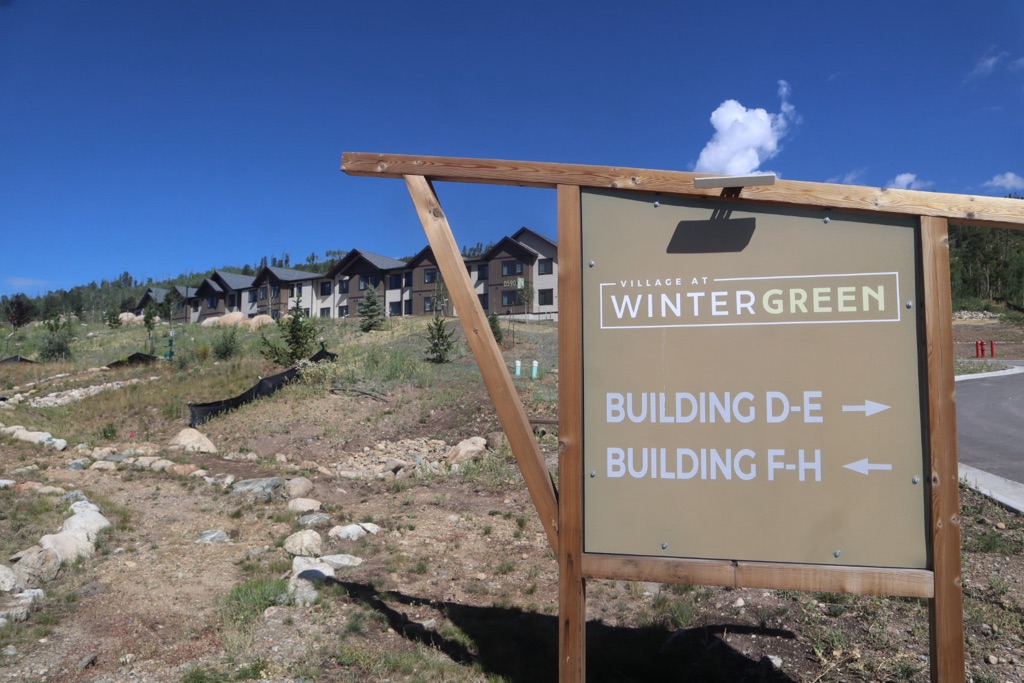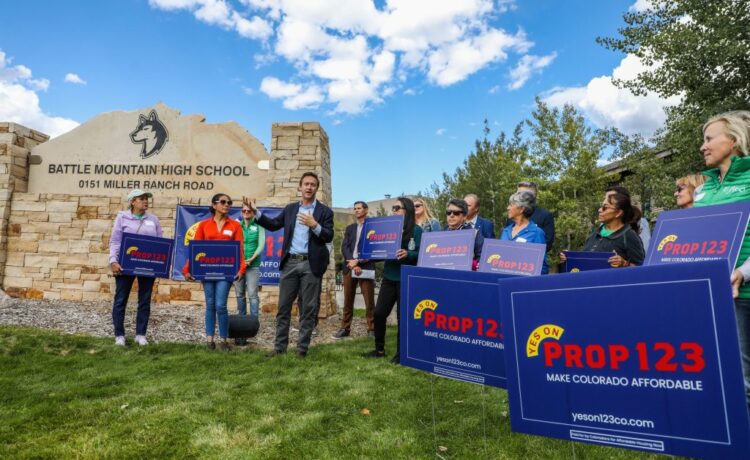
Chris Dillmann/Vail Daily
Roughly 20 months after voters approved the largest dedicated fund for affordable housing in Colorado history, some of the state’s highest-cost areas are seeing dollars trickle in.
State voters in November 2022 approved Proposition 123, which sets aside 0.1% of state income tax annually to fund local affordable housing efforts from development to land acquisition.
Over the past year, state officials approved the first round of funding using Proposition 123 money, which collected approximately $160 million during the state’s 2023-24 fiscal year. Because the fund wasn’t launched until the second half of the last fiscal year, it only saw half of what it is expected to collect within a full year.
By the end of the current 2024-25 fiscal year, the fund is expected to generate around $320 million, which will be made available to local governments, nonprofits and developers for a litany of housing programs. Future funding will be dependent on how much state tax revenue is generated each year.
“The big change that Proposition 123 has given the state of Colorado is a continuous source of funding for affordable housing that we never used to have,” said state Sen. Dylan Roberts, who represents mountain and Western Slope counties.
“We’ve seen a lot of towns in central and northwest Colorado take advantage of Proposition 123,” he said.
To date, 200 of Colorado’s 336 local jurisdictions have become eligible to apply for the funding after filing commitments with the state, according to Department of Local Affairs spokesperson Chynna Cowart.
Those include major resort hubs like the cities of Steamboat Springs and Aspen as well as Summit, Eagle, Grand and Pitkin counties, where average home costs hover in the millions.
The fund is split 60-40 between two state agencies that administer housing programs, with the bulk of the funds for development issued by the Colorado Housing and Finance Authority for land acquisition, equity investment and debt financing.
The Department of Local Affairs uses the other 40% of the funds for homeownership and homelessness initiatives — such as down payment assistance and housing vouchers — as well as support for local planning departments.
Of the $160 million that was available during the first round of funding, $26.9 million was issued by the housing authority for development projects in rural and resort counties across the western half of the state. Combined, those funds will create 685 affordable housing units.
Examples of awarded funds include:
Officials in mountain communities that have yet to apply for funds say they plan to do so before the end of this year.
Jason Peasley, executive director for the Yampa Valley Housing Authority, said his team is working on an application this month to receive Proposition 123 funds to support the construction of 63 for-sale condominiums in the Steamboat area — part of an overall 236-unit development.
“It’s a really direct benefit in that it allows us to sell units at a lower price point,” Peasley said.

Income limits, available land pose challenge
While the funds are beginning to translate to tangible success in rural resort areas, Proposition 123 also presents some hurdles for their affordable housing efforts, community leaders said.
Club 20 Executive Director Brittany Dixon, whose organization represents mountain and Western Slope counties, said when Proposition 123 was on the ballot the group opposed it.
“Not for the sense that we don’t think there should be affordable housing,” Dixon said. “We just felt that it didn’t address local building codes, labor shortages and the supply chain issues we’ve been seeing that all contribute to the cost of building housing.”
For local governments to receive funding under Proposition 123, officials must commit to increasing their affordable housing supply by at least 3% each year for the next three years. That can be a challenge in mountain communities where land development opportunities are limited and expensive, Dixon said.
The state also has income limits for the different programs funded through Proposition 123, with funds aimed at projects that help residents earning anywhere between 60% and 100% of the median income within a project’s area.
Local officials have long seen median income figures — which are based on a mix of federal and local data — as flawed.
These figures include not just wages but investment earnings, meaning in resort communities with small populations and wide income disparities, wealthier earners can skew the data. And because the cost of living in these areas is much higher than state and national averages, median income cutoffs can limit the kinds of housing opportunities community leaders hope to provide.

While state and federal funds exist to finance low-income housing, officials in rural resort areas say there also needs to be a focus on the “missing middle,” a reference to middle-income earners who don’t qualify for income-based housing but still don’t make enough to afford a market-rate home.
Steamboat, for instance, made national headlines earlier this year after the city struggled to hire a head of human resources despite offering a salary of $167,000 while doctors willing to pay more than $1 million for a home were being outbid by all-cash buyers.
“In a lot of our resort communities there’s doctors and nurses that can’t afford to buy a house,” Dixon said. “And if we can’t get doctors to come to these more remote areas because they can’t afford to live in these places, we can’t provide the services that our community needs.”
Eagle County Chief Financial Officer Jill Klosterman said income limits are “one of the big things that we’ve been working on that has impeded our access to the funds.” Klosterman added that 86% of the county’s land is owned by the U.S. Forest Service “and of the 14% that remains, it is on very steep slopes. So we just have very limited land where we can build.”
For those reasons, meeting the goal of increasing the county’s affordable housing supply by 3% year-over-year “will be a challenge,” Klosterman said.
It will take an all-of-the-above approach that includes public-private partnerships and preserving the affordability of existing homes through tools like deed-restrictions, which limit a home’s appreciation value.
“That takes a long time and a lot of effort,” Klosterman said. “But that’s the reality. We’re not going to be able to build our way out of this issue — there just isn’t enough land.”
Roberts, the state senator, said he hopes the funding that comes from Proposition 123 will help communities meet their affordability goals rather than hinder it.
By having a dedicated housing fund that officials hope will exist in perpetuity, Roberts said Proposition 123 could take pressure off other competitive financing opportunities for housing. The 3% yearly housing goal includes any and all projects, not just ones that are funded through Proposition 123.
Roberts also sponsored a bill passed by lawmakers last year that allows rural resort communities to petition to raise area median income limits when applying for the funds.
Under the new law, local governments can be approved for up to 140% of an area’s median income figures for certain projects, so long as officials meet certain criteria, like having an updated housing needs assessment. The town of Frisco, for example, successfully petitioned to raise income limits on Proposition 123 funds it received in February for a land purchase.
The 140% income maximum is “probably still too low for some projects and some communities in the mountains, but we are glad we were able to get a little bit of variance there,” said Roberts, adding that state lawmakers “would be very willing to look at any changes that are needed to make the program better.”
‘It feels like progress’
For all its imperfections, Proposition 123 is a critical step in the right direction for Colorado’s affordable housing efforts, said Elyse Howard, who sits on the board for Habitat for Humanity of Colorado.
The statewide organization was approved for $5 million from the fund during the last application cycle, with those dollars going to regional Habitat groups building a total of 70 for-sale units.
“It feels like progress,” said Howard, who also serves as director of development
for Habitat for Humanity Vail Valley. “Proposition 123 has set a new bar.”
In recent years, Habitat for Humanity Vail Valley has been able to double its home development, going from 20 units developed between 2019 and 2021 to 40 units between 2022 and 2024, Howard said.
Howard credits that to the massive infusion of federal funds that states and local governments saw during the first years of the COVID-19 pandemic, when Congress passed trillions of dollars in relief packages. Those dollars came to Habitat in the form of state grants, with Howard saying the funds helped bolster the group’s ability to pay for major construction projects.
Now, those funds have dried up. But Proposition 123 will help soften the financial blow, Howard said.

Habitat for Humanity Vail Valley is set to receive $650,000 of the $5 million in Proposition 123 funds that was acquired by the state group. Those dollars will help pay for nine new homes being developed as part of a 76-home neighborhood in Gypsum.
“We’ve shown when more money is invested in homeownership from the state we can double or triple the production of homeownership units,” Howard said. “And I think it is our job to speak up for our communities to get more dollars.”
But even with the new bucket of state funding, the local Habitat group faces millions of dollars less compared to what it was receiving during the pandemic. Proposition 123 will help, but it won’t be the only solution.
“We have a bigger gap to make up in order to maintain this level of (home) production,” Howard said. “Housing is expensive, and there’s never enough funding for it.”
Local leaders who, despite seeing challenges with Proposition 123’s implementation, say the funds will still be an important piece of moving housing projects forward.
Klosterman, the Eagle County finance officer, said the county’s housing authority is likely to apply for funding to support its West Eagle project, which could see over 100 new below-market-rate units developed in the town of Eagle.
The county is currently updating its housing needs assessment that it will need to successfully petition the state for a higher median income limit, Klosterman said.
“We want to use Proposition 123 money to fill the gap of what it actually costs for construction here in Eagle County and what we can sell it for,” Klosterman said.”Those are dollars that we’ve never had as an affordable housing industry.”
Dixon, the Club 20 president, said while not all programs funded under Proposition 123 will work for rural resort communities, “Everyone is grateful that it is a priority of the state to address the housing shortage.”
“I think there’s a long way to go,” Dixon said. “It’s just one more tool in the toolbox.”
Elliott Wenzler is the Western Slope politics reporter for the Craig Press and its sister publications in Glenwood Springs, Vail, Steamboat Springs, Craig, Summit County and Grand County. Reach her at ewenzler@swiftcom.com.
















